Mannans and endo-β-mannanases (MAN) in Brachypodium distachyon: expression profiling and possible role of the BdMAN genes during coleorhiza-limited seed germination
- PMID: 25922488
- PMCID: PMC4473977
- DOI: 10.1093/jxb/erv168
Mannans and endo-β-mannanases (MAN) in Brachypodium distachyon: expression profiling and possible role of the BdMAN genes during coleorhiza-limited seed germination
Abstract
Immunolocalization of mannans in the seeds of Brachypodium distachyon reveals the presence of these polysaccharides in the root embryo and in the coleorhiza in the early stages of germination (12h), decreasing thereafter to the point of being hardly detected at 27h. Concurrently, the activity of endo-β-mannanases (MANs; EC 3.2.1.78) that catalyse the hydrolysis of β-1,4 bonds in mannan polymers, increases as germination progresses. The MAN gene family is represented by six members in the Brachypodium genome, and their expression has been explored in different organs and especially in germinating seeds. Transcripts of BdMAN2, BdMAN4 and BdMAN6 accumulate in embryos, with a maximum at 24-30h, and are detected in the coleorhiza and in the root by in situ hybridization analyses, before root protrusion (germination sensu stricto). BdMAN4 is not only present in the embryo root and coleorhiza, but is abundant in the de-embryonated (endosperm) imbibed seeds, while BdMAN2 and BdMAN6 are faintly expressed in endosperm during post-germination (36-42h). BdMAN4 and BdMAN6 transcripts are detected in the aleurone layer. These data indicate that BdMAN2, BdMAN4 and BdMAN6 are important for germination sensu stricto and that BdMAN4 and BdMAN6 may also influence reserve mobilization. Whether the coleorhiza in monocots and the micropylar endosperm in eudicots have similar functions, is discussed.
Keywords: BdMAN gene family; Brachypodium distachyon; MAN gene expression; coleorhiza; endo-β-mannanases; germination; mRNA in situ hybridization.; mannan immunolocalization.
© The Author 2015. Published by Oxford University Press on behalf of the Society for Experimental Biology.
Figures
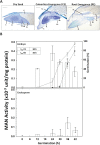

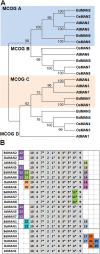
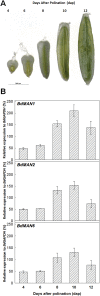

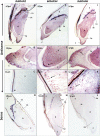
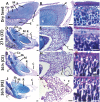
Similar articles
-
Three endo-β-mannanase genes expressed in the micropylar endosperm and in the radicle influence germination of Arabidopsis thaliana seeds.Planta. 2011 Jan;233(1):25-36. doi: 10.1007/s00425-010-1257-z. Epub 2010 Sep 28. Planta. 2011. PMID: 20878180
-
Mannans and endo-β-mannanase transcripts are located in different seed compartments during Brassicaceae germination.Planta. 2018 Mar;247(3):649-661. doi: 10.1007/s00425-017-2815-4. Epub 2017 Nov 21. Planta. 2018. PMID: 29164367
-
Softening-up mannan-rich cell walls.J Exp Bot. 2012 Jun;63(11):3976-88. doi: 10.1093/jxb/ers096. Epub 2012 May 2. J Exp Bot. 2012. PMID: 22553284 Review.
-
A Possible Role of the Aleurone Expressed Gene HvMAN1 in the Hydrolysis of the Cell Wall Mannans of the Starchy Endosperm in Germinating Hordeum vulgare L. Seeds.Front Plant Sci. 2020 Jan 20;10:1706. doi: 10.3389/fpls.2019.01706. eCollection 2019. Front Plant Sci. 2020. PMID: 32038680 Free PMC article.
-
Re-interpreting the role of endo-beta-mannanases as mannan endotransglycosylase/hydrolases in the plant cell wall.Ann Bot. 2009 Aug;104(2):197-204. doi: 10.1093/aob/mcp120. Epub 2009 May 19. Ann Bot. 2009. PMID: 19454593 Free PMC article. Review.
Cited by
-
Heterologous expression of MirMAN enhances root development and salt tolerance in Arabidopsis.Front Plant Sci. 2023 Apr 14;14:1118548. doi: 10.3389/fpls.2023.1118548. eCollection 2023. Front Plant Sci. 2023. PMID: 37123825 Free PMC article.
-
Identification of Reference Genes for Precise Expression Analysis during Germination in Chenopodium quinoa Seeds under Salt Stress.Int J Mol Sci. 2023 Nov 1;24(21):15878. doi: 10.3390/ijms242115878. Int J Mol Sci. 2023. PMID: 37958860 Free PMC article.
-
KAR1-induced dormancy release in Avena fatua caryopses involves reduction of caryopsis sensitivity to ABA and ABA/GAs ratio in coleorhiza and radicle.Planta. 2024 Apr 18;259(6):126. doi: 10.1007/s00425-024-04387-1. Planta. 2024. PMID: 38635035 Free PMC article.
-
Mitochondrial AtTrxo1 is transcriptionally regulated by AtbZIP9 and AtAZF2 and affects seed germination under saline conditions.J Exp Bot. 2017 Feb 1;68(5):1025-1038. doi: 10.1093/jxb/erx012. J Exp Bot. 2017. PMID: 28184497 Free PMC article.
-
Roles of Reactive Oxygen Species and Mitochondria in Seed Germination.Front Plant Sci. 2021 Dec 9;12:781734. doi: 10.3389/fpls.2021.781734. eCollection 2021. Front Plant Sci. 2021. PMID: 34956279 Free PMC article. Review.
References
-
- Akiyama T, Pillai MA, Sentoku N. 2004. Cloning, characterization and expression of OsGLN2, a rice endo-1,3-beta-glucanase gene regulated developmentally in flowers and hormonally in germinating seeds. Planta 220, 129–139. - PubMed
-
- Barrero JM, Jacobsen JV, Talbot MJ, White RG, Swain SM, Garvin DF, Gubler F. 2012. Grain dormancy and light quality effects on germination in the model grass Brachypodium distachyon. New Phytologist 93, 376–386. - PubMed
Publication types
MeSH terms
Substances
LinkOut - more resources
Full Text Sources
Other Literature Sources

